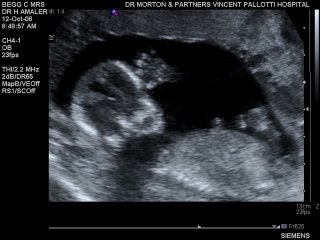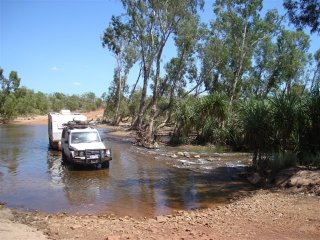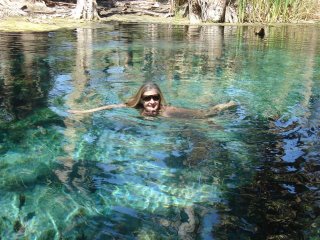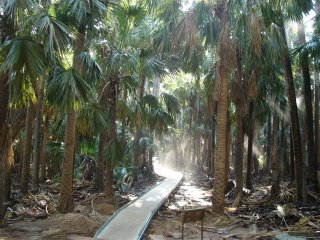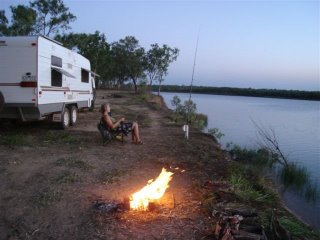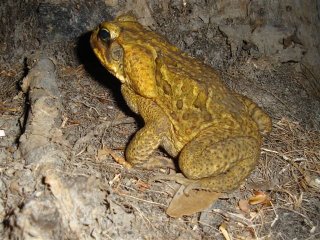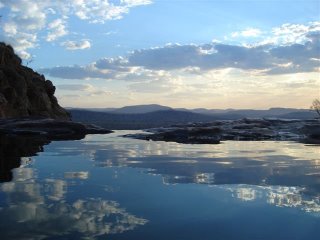
Replica of Krys outside offices of the local Shire - Normanton
Our next stop was the local library to use their internet facility. Yet again, we suffered frustration sending off two weeks of blog, this time returning to Getaway to load everything onto a disc to see if that would make a difference with the photos. Using a call box to confirm their arrival with Saxon we discovered all had been in vain. No matter, she was at bursting point at this contact to share Keith and Colleen’s momentous news of their baby due early April 2007. Our spirits rose three-fold, we stopped fretting about technology, resorted to posting the disc express to Perth, and retired to wallow in the caravan’s park Jacuzzi, fed by artesian water, while savouring the sheer joy of new lives to come, not only in Australia but South Africa too, six weeks apart. We are blessed.
Normanton is a bit of an anomaly as it was established in 1868 as an important port and yet it is 50km upriver from the Gulf and 70km by road. However, it has a railway line of great historical and technical importance (something that would greatly interest our only train buff friend Piet Smith in Durban). The Gulflander is a significant tourist attraction delivering mail between Normanton and Croydon. Affectionately known as the “Tin Hare” which tickled our fancy! As a result Lea wanted a ride but our timing is out as it leaves Normanton on a Wednesday. We enjoyed looking around the station, a classic example of Victorian architecture and seeing the Gulflander rail-motor parked within. Out in the 2006 prize-winning business garden we made the acquaintance with Gregory and Mrs Peck! Two tame brolga cranes that roam the station grounds.
After our visit to the station we called in at the Bakery before leaving Normanton. As we crossed the Norman River we could see some impressive waterholes and wetlands, full of wading birds, including Brolga and Black-necked Storks. Although we are making our way to Karumba we didn’t travel far as we were happy to spend the rest of the day in a bush camp beside Walker’s creek. We had pick of the sites and chose a prime spot above the river which proved to be an ideal viewing platform to watch a variety of herons (night heron included) stalking along the banks. At lunch time a Winnebago pulled in with a Canadian couple. Once they had ascertained we were staying overnight – they were happy to follow suit.
Unlike the rest areas in the other States and Territory covered we have been surprised to find Queensland’s rest areas in the northern outback poorly signposted and hardly conducive to stopping over for long. Taking a walk around Walker’s Creek in the evening we found its littered condition a dreadful indictment to fellow campers / picnickers and the local Shire. Although toilets had been provided the amount of faeces and toilet paper lying in the open was an embarrassment to us as Australians, especially with Canadian tourists in the bush camp. Despite being within an alcohol restricted area we came across beer cartons and piles of cans left without a care beside the bridge. Not to mention the VB and XXXX cans we have noticed growing wild along the Savannah Way in general.
Closing up Getaway in readiness for departure to Karumba we were amazed by the grey clouds gathering overhead. Even during our 40km journey our eyes were drawn upwards to this unexpected cloud movement after being so used to cloudless blue skies. On booking into the Karumba Point Sunset Caravan Park George commented on the cloudy day. The owner said it was most unusual so George couldn’t help asking whether it had anything to do with “cloud propagation”. Nonplussed! She thought fast before saying “do you mean the Morning Glory”? And with that she fetched a photo of this incredible natural phenomenon. Lea was called in and we finally learnt that the Morning Glory is a massively long, cylindrically-shaped cloud that forms inland and rolls towards the Gulf before breaking up at sea. It happens seasonally – normally at the start of spring although this year it happened in July. Her eye-witness account describes this rolling cloud roaring like a noisy train as it moves overhead, whips up dust and debris as it passes over the land and once over the water the sea becomes choppy. It sounded amazing and we feel better for not having gone to Burketown specially to see it, as its season had already passed.

The Morning Glory - propagating roll cloud
Finally, we look upon the Gulf of Carpentaria. Whew. It has been quite a journey! The flatness of the terrain means that one literally has to walk to the shore to see the massive stretch of flat water with a hint of green in colour. At least it is not muddy like the Cambridge Gulf or King Sound or so we thought! There are two parts to the little town. Karumba Point, where we are camped, faces onto the Gulf whereas the town itself is on the Norman River.
Ceremonial time for the sun took us straight from our camp over the fore-dune onto the sandy Point, only to find the tide out and the flats covered in mud. The sea was now rough and highly turbid, quite different from the morning. On the river side of the Point we found a string of fishers (men and women) as Karumba is another fishing heaven. They stand well back on the beach as on the opposite bank is a dense fringe of mangroves, ideal for salties.
Boat trailers and trucks rattling down to the boat ramp woke us at an unearthly hour. As a result of the fisherman’s dawn patrol we found ourselves backtracking to Normanton far earlier in the day than normal. From there we took the road to Croydon keeping our eyes peeled for The Gulflander returning to Normanton. At the critical moment Lea changed position in her seat when it flashed by, partly obscured by trees. Croydon, once the fourth largest town in Queensland, was full of the quaintest little buildings made of corrugated iron, a legacy of its gold-mining hey-day. Just out of town is Lake Belmont, water supply to Croydon. A gem of a place tucked in amongst some hills making it a perfect place for our lunch and a swim. After leaving Croydon the landscape changed noticeably from huge flat grasslands to more broken terrain covered in pure stands of Acacia. We thought we’d have one last bush camp in the Gulf savannah at Gilbert River rest area. If it wasn’t for our travel bible we would have no idea of this 48hr stop-over. No signage – just little dusty clearings that could easily be missed, as indeed we did.
In the early hours of the morning a far-carrying sound we’d not heard before broke the silence, giving Lea the creeps wondering what could have disturbed some birds at that time and tried to memorize the sound to tell George in the morning. However, he recognised the calls that came again at first light as that of Brolgas. Neither of us could begin to mimic what we had heard so we checked the bird book to see how the experts described it and came to the conclusion that we had heard cranes.
Passing through the little Outback communities, this time Georgetown and Mt Surprise, is like stepping back well in time. Even the main road reminded us of the days we used to travel on strip roads in Rhodesia as kids. Strange to come across it all these years later - almost as if the Outback has been forgotten or comes off second best. Mt Surprise was surprising! Just prior to entering Lea read out a sign Help Protect our Environment to which George muttered “What a stupid comment”! Following on from this sign were others …. Help Prevent the Spread of Weeds … for the sake of a minute’s delay you can help ….. By now we were most curious and there at the entrance to the village was a pull over directing us to a Wash-down Facility. We watched a truck first to see what to do. Lea leapt out to take a photo of Skiv and Getaway going through an automatic under-carriage spray. A first time for everything!

Wash-down facility outside Mt Surprise - to prevent spread of weeds
We had Undara Volcanic National Park as our next destination. We had no sooner read about it in a book than our hitch-hiker Ed furthered our interest. We found the Undara resort to have been skilfully developed, particularly in the way old railway carriages have been utilised for accommodation. Their long narrow form fitted into the corridors of the woodlands and obviated the need to cut down any trees. Six generations of Collins family have lived on this station, exploring the strange formations beneath their land before having it gazetted a National Park and scientists arrived to study the lava tubes. The only way of visiting the tubes is with a tour group led by the acclaimed Savannah Guides. Bookings recommended but we managed to get onto a two hour afternoon tour. We were fascinated to learn of 164 small volcanoes in this region. Undara volcano erupted violently about 190 000 years ago with its molten lava flowing quickly through low points of the landscape. The tubes formed as “the top outer layer cooled and formed a crust, the fiery magma below drained outwards leaving a series of long, dark, hollow tubes”.

The Archway at entrance to lava tube with rain forest in background - Undara
We gained access into two tubes in the area at one of the many places where ancient roof collapses have occurred. Using a network of board-walks to preserve this natural geological wonder we were shown the different lava level lines and the dangling roots of vegetation above us (in fact our bus had parked close to these trees). Walking down the dark tubes with the aid of our guide’s torchlight reminded us of our Tunnel Creek experience. Roosting in the many cracks and crevices were tiny Horseshoe Bats (small enough to fit into a matchbox) which in turn attract many creatures preying on each other. February is considered the best month to do a sunset tour as snakes hang from the branches of trees at the tube entrances where fertile pockets of rain forest have developed, waiting to grab the unsuspecting bats as they emerge for their nightly feeding.
Our evening in the van park was punctuated by a variety of bird calls, some not heard before and others a good while ago. Best was to hear the Laughing Kookaburra again. After dinner we walked down to the Evening Campfire held in front of dining area - a choice of eating outdoors or in carefully restored dining cars all under a domed roof replicating a railway station all looking out onto a campfire backed by the woodland. Free evening activities are held at this campfire by the Savannah Guides. This night it was a slide show on Undara fauna with a northern bettong (a small rat-like kangaroo) gate-crashing and stealing the show. Despite the big campfire we were cold! George insisted on having his “Skehely blankey” removed from storage.
Next morning we took the walk around the rim of the Kalkani crater - a scoria cone with panoramic views across the Undara Volcanic National Park. Delineated by the trees within it we could visibly see the path of the lava tube winding across the landscape. It is amazing to think that this is the longest flow (160km) from a single vent known anywhere in the world. Heading on east we arrived at Forty Mile Scrub National Park and took the short walk into this rare semi-evergreen vine thicket before having our lunch. A male Brush Turkey with his bright yellow wattle encircling his neck like a scarf joined us. We were put off spending the rest of the weekend here as it was so close to the “main” road (rough, steeply edged strip road) and the wretched road trains that we pushed on through Mt Garnet and Innot Hot Springs until we reached Archer Creek. A most attractive place and the first well maintained, signposted rest area we have come across in Queensland. We were happy to drop anchor for the weekend. With the foothills of the Great Divide approaching the evenings are much cooler and it is not only us that can feel the difference. We noticed the other campers here put on jumpers and long trousers.
